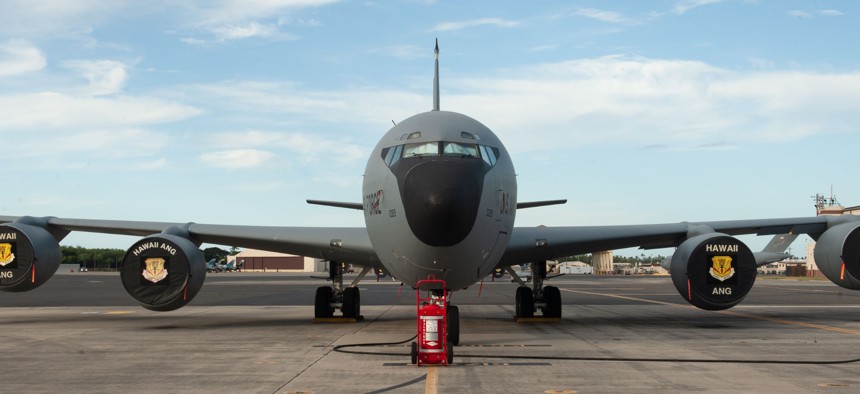
Just how old are the Air Force's KC-135 Stratotankers? The last one was delivered in 1965. Two years later, this particular KC-135 won the Mackay Trophy for the most meritorious flight of the year. National Museum of the Air Force
Air Force Slashes ‘Bridge Tanker’ Buy, Sets Deadline for Clean-Sheet Aerial Refueler
Stealthy new tanker jet should arrive in the 2030s, service’s top weapons buyer says.
The U.S. Air Force is shrinking its next planned purchase of tanker aircraft—the ones made to a modified-jetliner design—and getting serious about its stealthy next-gen aerial refueler.
The service will buy only 75 tankers in its upcoming “Bridge Tanker” tranche, Andrew Hunter, the service’s top weapons buyer, announced Monday evening at an Air Force Association conference in Aurora, Colorado. That’s down from the “up to 160” aircraft that Air Force Secretary Frank Kendall talked about last year.
Hunter also offered new details on the tanker after that: he said the Next-Generation Aerial Refueling System, or NGAS, needs to be able to fly deeper into contested airspace and have more self-protection and advanced networking than the current KC-135, KC-10, and KC-46 tankers. He said service leaders want NGAS flying before the end of the 2030s.
The decision to consider “a clean-sheet-of-paper approach not constrained to commercial-derivative aircraft” was driven by “threats that are posed by potential adversaries to high-value aircraft, including tankers,” he said. “We have to have an approach that allows us to address those threats and still refuel the joint force and allow it to engage them [in] all of the critical operations that are required for high-intensity conflict.”
Service officials said they want to hold a competition for the new aircraft.
For two decades, the Air Force has been buying tankers under a three-aircraft plan. The first two parts of that plan included buying commercially modified tankers. The third phase was to buy a new-generation aircraft.
After two decades, the Air Force is still in the first phase of that plan: buying 179 KC-46 tankers, which are modified Boeing 767s. The second part, the Bridge Tanker, is being cut from 160 to 75 planes over five years, Hunter said, adding that they will likely be KC-46s as well.
“We do expect based on the information that industry has previously provided that that may lead us towards KC-46 is the answer,” Hunter said.
That’s sure to draw the ire of some lawmakers who have pushed for competition. Lockheed Martin has teamed with European aircraft manufacturer Airbus to pitch a modified A330 tanker. The Air Force chose the KC-46 over the larger A330 tanker in 2011.
But Boeing has struggled to deliver the KC-46. Numerous developmental problems have cost the company more than $5 billion on the project.
In recent months, L3Harris Technologies said it was building a tanker from a twin-engine Embraer KC-390 cargo plane. The company was self-funding its so-called Agile Tanker program in hopes the Air Force would consider it in phase three of its tanker buys.
The plan for a new-design tanker begs a multibillion-dollar question. For more than two decades, Air Force leaders have claimed the service’s future needs are well outside of its means. How will a new-design tanker fit into the budget?
Don't miss:




